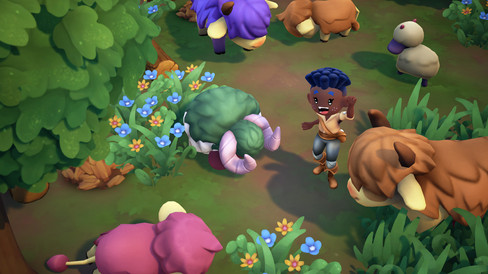Review: Fae Farm
- Laura Collins
- Sep 20, 2023
- 4 min read

As an avid lover of simulation games, particularly those of the farming variety, my heart was quickly captured by the spellbinding world of Fae Farm. The journey quickly had me immediately engrossed and just a little obsessed.
The tale commences with a leisurely stroll along the beach, where fate delivers an unexpected message in a bottle, accompanied by a charming rhyme that beckons you to the land of Azoria. Upon arrival, you're introduced to Mayor Merritt, who discloses her aspiration to restore the dilapidated farm. This initial premise may seem familiar to seasoned players of farming simulations, yet it offers a fresh twist. Merritt, undeterred by the town's challenges of blizzards, whirlpools, an active volcano, and reanimated "junk" in the mines, staunchly believes in Azoria's potential as a thriving haven.
Upon seeing your new home for the first time, you’ll receive a welcome package from Merritt reminiscent of the genre's hallmark. You’re then guided through the initial steps of farming life: tilling soil, planting crops, smashing rocks, cutting lumber, and gathering materials. Personalizing your home echoes the charm of Animal Crossing, with added benefits. The act of furnishing your space not only grants cozy aesthetics but also bolsters your health, energy, and mana reserves.
A small yet invaluable touch lies in the seamless transition between tools. Whether you're watering crops, mining for resources, or felling trees, the game intuitively equips the appropriate tool, eliminating the need for manual switching.
However, what sets Fae Farm apart is the delightful inclusion of the Almanac, a treasure trove of knowledge that fills itself automatically as you encounter new items or recipes scattered throughout the world. Gone are the days of back-and-forth referencing; everything you need to know is elegantly presented for your convenience. As with any worthy farming simulation, Fae Farm boasts a calendar marking birthdays and special events, preventing any heartfelt celebration from slipping through the cracks.

The farming experience in Fae Farm flourishes with unique intricacies. Cross-breeding flowers, like one does in Animal Crossing, provide you with different colors and types in which to add new entries to your Almanac as the seasons shift. Meanwhile, the availability of critters and fish for capture and catching also changes with the passage of time, season, and location, mirroring the rhythm of nature. If you’re not watchful for the changes, this could result in being unable to complete some quests that require a certain material or critter. It won’t soft-lock you, but this could prove troublesome for perfectionists like myself. Additionally, embracing the enchanting rhythm of the farm's cycle, Fae Farm dismisses the pressure of bedtime. Should the clock strike midnight, you're gently returned to your bed without any penalty.
Guiding magical creatures through nurturing, reminiscent of Harvest Moon, reveals intricate layers that deepen the gameplay. Breeding these creatures adds a layer of strategy and variety, inviting you to experiment a bit.
You’ll find that initially, certain parts of Azoria are inaccessible, but hope shines in the form of Alaric, a resident who gifts you a magical staff capable of dispelling thorny barriers blocking your path to unexplored areas. With this newfound tool, your journey truly commences, igniting the spark of adventure and possibility.
Scattered across the world, you’ll find recipes for customization, novelty, and crafting. These crafting stations range from culinary centers for food preparation to traditional lumber yards and stone forges, and even honey hives and potion-crafting sanctums, and that’s just to name a few. One of my favorites was the Critter Conservatory, an ingenious space to house creatures that, over time, bestow invaluable crafting materials.
Navigating the terrain proves remarkably seamless due to the well-crafted map, a companion that ensures you never lose sight of your objectives. Unlike some other games, where characters' locations can be a guessing game, Fae Farm's map dynamically tracks their movements and provides an intuitive breadcrumb trail directly to their whereabouts. Additionally, crafting seals for transportation eliminates any hassles of traversal, streamlining your farming experience.

Inventory upgrades start modestly, as with most other farming sims, but upgrades quickly become attainable, primarily through quests and market booth sales, which are completed overnight whilst you sleep. While your inventory might flourish and fill somewhat quickly, Fae Farm's storage shed seems to be bottomless. Yet, this does come with one minor quirk—the need to click on materials for identification. This can occasionally be tedious, particularly when you have many different kinds of materials, some with similar shapes or colors, though by all means, not a dealbreaker.
Venturing into the mines—an essential component of any farming simulator—ushers forth a familiar yet thrilling experience. Battling Azoria's unique denizens while excavating resources is not only rewarding but also forgiving. A depleted health bar doesn't spell doom; instead, you're transported back to safety, retaining the fruits of your labor.

The charming and varied cast of characters presents ample opportunities for relationships to blossom and, if you so choose, romance to bloom. In this mystical realm, interactions and bonds hold the potential to be as enchanting as the landscape itself.
There is also a multiplayer option where you share your progression and build a farm together, but I spent my time in the campaign.
Gratitude is owed to Phoenix Labs for providing me with a code to unlock this captivating journey. As the post-launch horizons of Fae Farm unfold, I eagerly anticipate the developments and evolutions that await this already exceptional game.













Comments